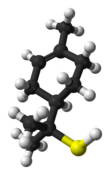Grapefruit mercaptan
| |||
| Names | |||
|---|---|---|---|
| Preferred IUPAC name 2-[(1R)-4-Methylcyclohex-3-en-1-yl]propane-2-thiol | |||
| Other names grapefruit mercaptan 1-p-menthene-8-thiol α,α,4-trimethylcyclohex-3-ene-1-methane thiol thioterpineol | |||
| Identifiers | |||
CAS Number |
| ||
3D model (JSmol) |
| ||
| ChemSpider |
| ||
| ECHA InfoCard | 100.072.886 | ||
| EC Number |
| ||
PubChem CID |
| ||
| UNII |
| ||
CompTox Dashboard (EPA) |
| ||
InChI
| |||
| |||
| Properties | |||
Chemical formula | C10H18S | ||
| Molar mass | 170.31 g/mol | ||
| Density | 1.03 g/cm3 | ||
| Melting point | < 25 °C (77 °F; 298 K) | ||
| Boiling point | 58 °C (136 °F; 331 K) at .33 mmHg | ||
| Hazards | |||
| GHS labelling: | |||
Pictograms |  | ||
| Warning | |||
Hazard statements | H302, H315, H319 | ||
Precautionary statements | P264, P270, P280, P301+P312, P302+P352, P305+P351+P338, P321, P330, P332+P313, P337+P313, P362, P501 | ||
Except where otherwise noted, data are given for materials in their standard state (at 25 °C [77 °F], 100 kPa).  N verify (what is N verify (what is  Y Y N ?) N ?) Infobox references | |||
Grapefruit mercaptan is a natural organic compound found in grapefruit. It is a monoterpenoid that contains a thiol (also known as a mercaptan) functional group. Structurally a hydroxy group of terpineol is replaced by the thiol in grapefruit mercaptan, so it also called thioterpineol. Volatile thiols typically have very strong, often unpleasant odors that can be detected by humans in very low concentrations. Grapefruit mercaptan has a very potent, but not unpleasant, odor, and it is the chemical constituent primarily responsible for the aroma of grapefruit.[1] This characteristic aroma is a property of only the R enantiomer.[2]
Pure grapefruit mercaptan, or citrus-derived oils rich in grapefruit mercaptan, are sometimes used in perfumery and the flavor industry to impart citrus aromas and flavors. However, both industries actively seek substitutes for grapefruit mercaptans for use as a grapefruit flavorant, since its decomposition products are often highly disagreeable to the human sense of smell.
The detection threshold for the (+)-(R) enantiomer of grapefruit mercaptan is 2×10−5 ppb, or equivalently a concentration of 2×10−14. This corresponds to being able to detect 2×10−5 mg in one metric ton of water - one of the lowest detection thresholds ever recorded for a naturally occurring compound.[3]
See also
- Nootkatone, another aroma compound in grapefruit
- Terpineol, where a hydroxyl is in place of the thiol
References
- ^ Buettner A.; Schieberle P. (1999). "Characterization of the Most Odor-Active Volatiles in Fresh, Hand-Squeezed Juice of Grapefruit (Citrus paradisi Macfayden)". J. Agric. Food Chem. 47 (12): 5189–5193. doi:10.1021/jf990071l. PMID 10606593.
- ^ Lehmann D.; Dietrich A.; Hener U.; Mosandl A. (1994). "Stereoisomeric flavor compounds. LXX: 1-p-menthene-8-thiol: separation and sensory evaluation of the enantiomers by enantioselective gas chromatography-olfactometry". Phytochemical Analysis. 6 (5): 255–257. doi:10.1002/pca.2800060506.
- ^ Demole, E.; Enggist, P.; Ohloff, G. (1982). "1-p-Menthene-8-thiol: A powerful flavor impact constituent of grapefruit juice (Citrus parodisi MACFAYDEN)". Helvetica Chimica Acta. 65 (6): 1785–1794. doi:10.1002/hlca.19820650614.












